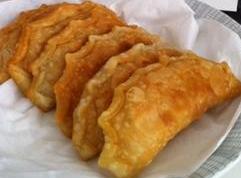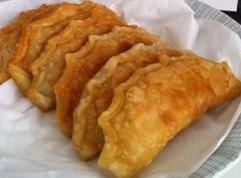Empanadas Valencian
Empanadas Valencian
These Valencian savoury empanadas are as easy as they are impressive.
Ready in: 30 minutes
Serves: 6
Complexity: easy
kcal: 124
Share

Ingredients
2 tbsp rice bran oil
1 onion, grated
1 tomato, peeled & chopped
110 g diced cooked ham
2 eggs, hard boiled & chopped
1½ tbsp fresh parsley, chopped
200 g Empanada dough
SIDS SALT & PEPPER to taste
1 tsp SIDS CRAZY SALT
Directions
In a large pan over medium heat, fry off onions until tender. Pour in tomatoes and cook for a minute then add the ham, SIDS SALT & PEPPER and heat through. Remove from the heat then mix in eggs, SIDS CRAZY SALT and parsley. Allow to cool for 6 minutes.
Preheat oven to 220°C. On a lightly floured surface, cut dough into 12 x 75 mm squares. Place equal amounts of filling into the centres of the squares, brush the edges with water then fold in half to form a triangle. Press the edges to seal then prick the middles with a fork and bake in the oven for 8-10 minutes until golden brown. Let stand for 5 minutes before serving.
HISTORY: Empanadas first appeared in Portugal around the time of the establishment of trade routes to India and the establishment of a Portuguese Colony at Goa and believed to have been derived or influenced by the Indian Samosa, known in Lisbon as the Chamuça da Goa. They first appeared in medieval Iberia during the time of the Moorish invasions. A cookbook published in Catalan in 1520, 'Libre del Coch' by Ruperto de Nola, mentions empanadas filled with seafood in the recipes for Catalan, Italian, French and Arabian food. In turn, empanadas and the similar calzones are both believed to be derived from the Indian meat-filled pies, samosas. All these pastries have common origins: India and the Middle East. Empanada was introduced to Brazil and Indonesia by the Portuguese colonizers and it still remains as a popular dish. It has also been introduced to Hispanic America and the Philippines by the Spanish colonizers. Empanadas in Latin America, the Philippines and Indonesia have various fillings.

